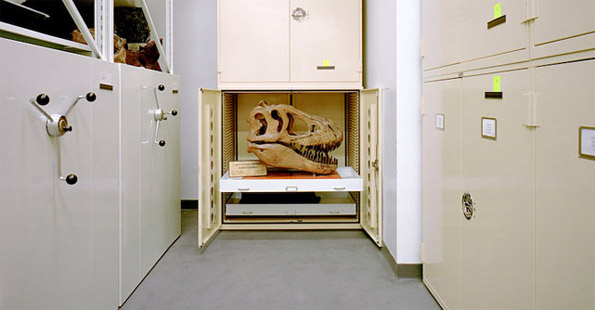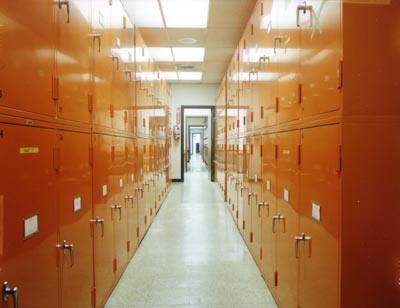
Image Credit: Justine Cooper
In Stuffed Animals and Pickled Heads: The Culture and Evolution of Natural History Museums, philosopher Stephen Asma argues for natural-history museums as rhetorical spaces, with “deep ideological commitments quietly shaping and editing the sorts of things different cultures and different historical epochs consider to be knowledge.” But what can we learn from the museum’s less public spaces? In her narrated slideshow “Saved by Science,” artist Justine Cooper’s behind-the-scenes photographs evoke an eerie dreamscape at the intersection of scientific collecting and human desire.
In 2005, the Australian-born Cooper was granted rare behind-the-scenes access to the American Museum of Natural History in New York. The results are fascinating for the way they both synthesize and dissect the artist’s and scientist’s modes of vision. In part, her photographs of "objects en masse" catalogue Cooper's journey toward a scientific gaze: "when you look closer at each of those individual specimens, you actually start to see individuality, difference." At the same time, Cooper recalls coming across a crate of cretaceous bones wrapped in newspaper from 100 years ago. Her paleontologist-guide noticed that one of the sheets was crumbling to reveal the bone of a T. Rex relative. But it was the wrappers themselves that caught Cooper’s eye, for the way they make visible that the specimens “aren’t just scientific objects, but are also wrapped in a cultural tissue.”

Image Credit: Justine Cooper
As the images here show, Cooper’s eye was repeatedly drawn to containers, which reflect not only available materials and technologies, but also more subjective curatorial choices. For example, the museum's anthropology collections for entire countries or continents are stored in sleek, space-age compartments arranged on a diagonal grid, their sterile anonymity begging the question of how a culture can be contained.
Some of the most poignant images here are ones that raise questions of scientific value and human motives. Cooper recalls feeling an affinity with a solitary lion’s head tagged “no data attached,” meaning that the animal’s death could not even be framed as serving the cause of scientific inquiry. The photograph reminded me of Andrea Barrett’s short story “Birds with No Feet,” which my students read in class earlier this semester. In the story, an Alfred-Russel-Wallace-like collector returns from the Malay Archipelago to a country in the midst of the Civil War; with no one interested in cataloguing his specimens, he comes to see his collecting, like his soldiering, as “another murderous journey.”
Other images are just plain fanciful: for example, coming across a fiberglass mold of Homo ergaster in the attic, the cast of which resides in the Hall of Human Biology, Cooper notes, “I could imagine a story where she’s running to join that part.” These photographs reveal--and revel in--the collection's “latent mystery,” while suggesting that its allure is intimately bound to the mystery of why we collect. Although humans are absent from these photographs, our imprint is everywhere. As Cooper finally asks, “Are we by nature obsessive, preservationist, or sentimental? Is it knowledge, ownership, or curiosity that drives us to collect?”
Ultimately, I’m drawn to "Saved by Science" as a model for the kind of interpretive, imaginative multimedia writing I would like my students to produce this semester. With 21 photographs and less than 8 minutes of narration, Cooper’s visual narrative accomplishes a great deal. In the classroom, how do we elicit (and guide) a similar process of critical analysis and immersive storytelling?


Recent comments
2 years 29 weeks ago
2 years 44 weeks ago
2 years 44 weeks ago
2 years 50 weeks ago
3 years 4 weeks ago
3 years 4 weeks ago
3 years 4 weeks ago
3 years 6 weeks ago
3 years 6 weeks ago
3 years 6 weeks ago